Sourdough Focaccia Bread Recipe
This sourdough focaccia bread has a crisp, golden crust and a soft, pillowy center thanks to a high-hydration dough and a generous pour of olive oil. It’s easy to make, flexible with timing, and perfect for adding your favorite toppings, like herbs, cheese, roasted garlic, or whatever you have on hand. See the notes section for topping ideas.
Servings: 12 servings
Ingredients
- 6 tablespoons olive oil divided 72 grams (plus more for the top)
- ⅔ cup active sourdough starter 100% hydration, 150 grams
- 1¾ cups water warmed to about 100°F, 414 grams
- 2 teaspoons salt or bread flour 12 grams
- 4 cups all-purpose flour 480 grams
- 2 teaspoons large-flake sea salt (such as Maldon) such as Maldon salt
Instructions
- Spray a 13 x 9 inch pan with non-stick spray then drizzle at least 3 tablespoons olive oil into the bottom. The spray keeps the dough from sticking and the oil makes the bottom and edges crunchy.
- In a large mixing bowl, combine the sourdough starter, warm water, 3 tablespoons of olive oil, flour, and salt.
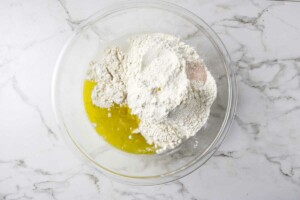
- Mix until a shaggy, sticky dough forms. It will feel quite wet at this stage, but that’s exactly what gives focaccia its soft, pillowy texture.
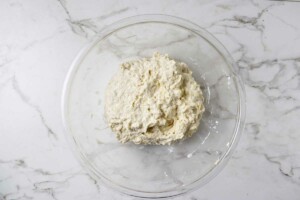
- Rest (autolyse-style) – optional but helpful: Let the dough rest for 30 to 40 minutes to help the flour hydrate. This makes the dough easier to work with.
Build the Dough Structure
- Over the next hour, perform 3 to 4 sets of stretch and folds, spacing them about 15–20 minutes apart. To do this, grab one edge of the dough, stretch it up, and fold it over toward the center. Turn the bowl and repeat on all sides. This helps build strength and elasticity without kneading.
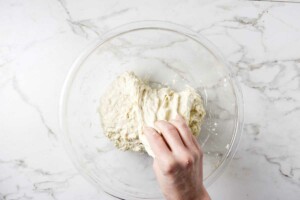
- Optional shortcut method: If you prefer not to do stretch and folds, you can beat the dough with an electric mixer on medium speed for about 2 minutes, until it’s smooth and slightly elastic. The dough won’t be quite as fluffy with this method but it will still taste amazing.
Bulk fermentation
- Cover the bowl and let the dough rise at room temperature (ideally around 72–75°F) for 4 to 6 hours, until it's noticeably puffy and expanded. It may not double completely but should be airy and jiggly. Alternatively, refrigerate the dough overnight for 8–16 hours for more flavor development.
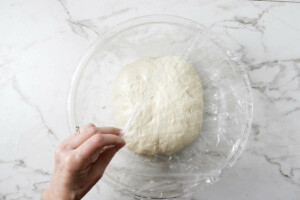
Second Rise (Pan Proof)
- For the Second Rise Transfer the dough into the prepared pan. Gently stretch it toward the edges. If it resists, let it rest 15–20 minutes and try again. Cover and let it rise until puffy and bubbly, about 2 to 3 hours at room temperature. (If cold from the fridge, allow more time.)
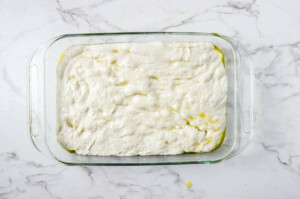
- Near the end of the rise, preheat your oven to 425°F. Drizzle a generous amount of olive oil over the surface (I don’t measure this, I just use a few glugs). Use your fingertips to gently dimple the dough all over. Press straight down without deflating too much.
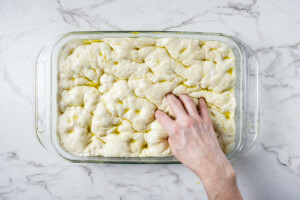
- If you're using toppings, scatter them over the dough (see notes for savory topping ideas). Sprinkle the top with flaky Maldon salt or another type of finishing salt.

Bake:
- Bake for 30–35 minutes (did 25 min cause it isn’t very thick), until deeply golden on top and edges are crisp. Check earlier if your oven runs hot. Let it rest in the pan for about 5 minutes, then transfer to a wire rack. Serve warm or at room temperature.
Notes
Flour Type: Bread flour gives you a slightly chewier texture with better structure, but all-purpose works just fine. If using all-purpose, the dough may spread a bit more.
Hydration Warning: This is a high-hydration dough, so don’t panic if it feels too wet to handle. It’s supposed to be sticky. Using wet hands during stretch and folds helps keep things manageable.
Fermentation Times: If your kitchen is cooler, expect longer rise times. If it’s warmer, things will move faster. Keep an eye on the dough rather than the clock.
Cold Fermentation: Refrigerating the dough overnight enhances the flavor and fits better into a busy schedule. After the cold proof, give it plenty of time to come to room temperature and puff up before baking.
Pan Size: This recipe is written for a 13x9-inch pan. You can use a slightly larger pan for thinner focaccia but you will need to shorten the bake time.
Add Toppings After Dimpling: If you're adding toppings, do it right after dimpling the dough and before baking. Wet toppings like tomatoes or olives can sink into the dough a bit during baking, which is totally fine.
Crispy Bottom Tip: Don’t skimp on the olive oil in the pan. It gives the bottom crust that classic, crispy texture and makes it easy to release from the pan.
Serving + Storage: Focaccia is best enjoyed the day it’s baked but can be stored at room temperature in an airtight container for 1–2 days. Reheat in the oven at 350°F for 5–10 minutes to revive the texture. You can also freeze slices and reheat straight from frozen.
Ideas for Savory Toppings:
- Sliced jalapeños and cubes of sharp cheddar
- Cherry tomatoes, sliced green olives, and crumbled blue cheese
- Roasted garlic cloves and fresh rosemary leaves
- Artichokes, sun-dried tomatoes, and Parmesan
- Feta, kalamata olives, and oregano
- Asparagus, lemon zest, and ricotta (add ricotta post-bake)
- Pickled jalapeños and smoked provolone
- Sautéed wild mushrooms, caramelized onions, and thyme
- Fig jam, blue cheese, and prosciutto (add jam + prosciutto post-bake)
Nutrition
Serving: 1 serving | Calories: 226kcal | Carbohydrates: 34g | Protein: 5g | Fat: 7g | Saturated Fat: 1g | Polyunsaturated Fat: 1g | Monounsaturated Fat: 5g | Sodium: 390mg | Potassium: 45mg | Fiber: 1g | Sugar: 0.1g | Calcium: 8mg | Iron: 2mg
